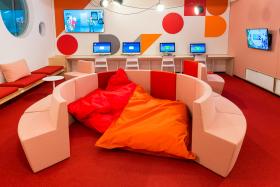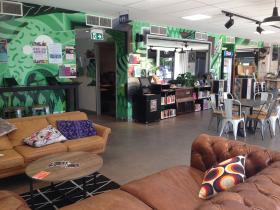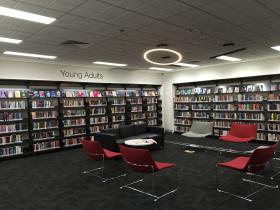Service area: Youth
Successful youth areas reflect the values and attitudes of local young people.
A separate, dedicated youth space may not be appropriate for all libraries. However, a library that is relevant to local young people with suitable collections, technology and a variety of spaces is crucial in contemporary library design and planning.
Youth culture
Youth is generally defined as those aged 13–24 years old, with older youth often still dependent and engaged in further education. They are significant users of public libraries and major consumers of information technology. The education of today’s youth combines individual learning, co-operative learning, research and group interaction. Thus, in addition to quiet study, students interact, discuss and develop ideas together in a co-operative manner. As a place away from home and school, libraries can act as a place of refuge for youth, to meet with friends or be by themselves. Increasingly the delineation between recreational time is blurred with study activity. The current youth generation seeks and consumes information in different ways and educational theory and practice has responded accordingly.
Spaces for multi-tasking
An important aspect of contemporary youth culture is the fluid approach to activities and proficiency with multi-tasking, meaning younger generations often like to work, chat, use technology and do numerous other things at the same time. Many libraries are responding to these specific needs by providing separate areas that allow young people to undertake a range of activities in a space designed especially for multi-tasking.

Technology
Technology is another key aspect of youth culture. Young adults are generally interested in, and quick to learn, new technology and have been key users of the increasing technological resources of libraries. Younger generations have shown to be particularly interested in audiovisual environments, which are dynamic, interactive and instantly responsive. When public libraries begin to provide these facilities, youth have been seen to be among the first to embrace them.
Group and individual spaces
In the broader library context, the physical outcomes of this trend are a demand for both group and individual spaces as well as noisy and quiet areas. Most afternoons in libraries, youth make use of communal study tables, lounge areas, IT areas and meeting rooms. Library infrastructure for wireless Internet and laptop use complements the existing provision of online school resources and web pages used by young people.
The design of youth areas is integral in attracting and maintaining patronage of public libraries by young people. Upgrades and new libraries typically result in an increase in visitation by young clients.
Essential design features
Location
It is advisable to locate the youth area away from the children’s area as young people do not like to be viewed as children. Also consider separation from areas such as Local History which may be more quiet and contemplative spaces.

Furniture
Flexible pieces allow youth to take ownership of their immediate surroundings by rearranging and adapting furniture to suit their needs. A variety of seating options provides choice. Typical furniture for youth might include: fixed benches or seating booths along a wall, group study zones, OPAC desks, loose lounging elements such as chairs, sofas, bean bags, ottomans, and floor cushions, which can be moved around by users.
Fitout
A good youth area is a space that reflects the era that young people live in and can easily relate to. By employing contemporary trends in colour, patterns and textures, styles of furniture and fittings, an atmosphere can be created that is instantly recognisable as youthful, vibrant and exciting. Consider user contributions and user created content as part of design e.g. graphics, wall art and display.
Enclosure and spatial delineation
Privacy and trust are important to young people. In a successful youth area, users should not feel the overwhelming intrusion of authority. The need for adult supervision can easily be balanced with a desire for privacy by creating semi-enclosed or spatially delineated areas. This can be achieved by using elements such as low walls, semi-transparent screens or curtains, strategic placement of bookshelves or changes in floor level.
Further considerations

Integrating technology
Integrating technology such as game consoles, large screens, music players, computers and power points for laptops. Additional specialised features such as sound mixing and video editing equipment would benefit from being in a separate room.
Collections
Locating library collections for young people near the youth area is recommended. This includes graphic novels, teen magazines, gaming, and teen health/information brochures, HSC collections.
Study tables
Group study tables for students are often in high demand during after school hours. It is a good idea to have a dedicated work area for students where they are free to chat and collaborate on group projects without disturbing other library users.
Outdoor space
If available, access to a covered outdoor area with furniture options for congregating, lounging and studying.